#aranyaka
Explore tagged Tumblr posts
Text
a collection of things kaeya foreshadowed
(copy pasted directly from reddit) one of the main appeal points in Kaeya for me is just how much potential his character holds, and how that gets proven with every new main story-centric update. Everything Kaeya says holds a certain double meaning, and we only get to find them out when we know more, so I thought I'd compile all the things (that I know of) that Kaeya has foreshadowed or teased in one way or another because I feel like I never see anybody mention how many things he's said before started making more sense after we knew more things?
starting with his story quest (1.0) predicts a couple of things! the first one being the first three nations' plotlines. Dvalin being the 'wicked abyss dragon' and Osial being the 'hydra', then in Inazuma signora being the 'silver-haired banshee' (for those who don't know Signora's lore centres around her actions being motivated by grief over the loss of her husband I'm pretty sure, so she can vaguely check the banshee title off)

These connections were proven further in Sumeru! During the Aranyaka (3.0) quest, specifically in a section called 'The Children of Vimara Village' the traveller is asked to tell three kids stories. Paimon references Kaeya directly and they follow the template of telling the children stories about our feats by following what Kaeya has said.

I won't include the whole dialogue section because it would be too long. But essentially: they tell Iotham about Dvalin, Kavus about Osial, and Sudabeh about Ei and Yae Miko. I believe that might be because Signora's story and ending aren't exactly suitable for children, given that she got executed by one of the 'distinguished ladies' after losing a match to the death against the traveller.
Later in the Caribert quest we meet Kaeya at the start and find out he's the descendant of the Abyss Order's founder, Clothar. Now, stay with me please, I admit that this might be a stretch on my part but I do believe if you squint your eyes it makes sense, but what if I tell you that was also foreshadowed in his story quest?
In his story quest, he talks about his grandfather and the sword he had. at the end of the quest, Kaeya does give us the harbinger of dawn to make up for him tricking us. now, if we take into account the time loop theory (which has been proven to at least some extent with the Aranara and all) and the fact that since Kaeya is a descendant of Clothar and our sibling is the prince/princess of the abyss order which Clothar founded, you could kind of say they're vaguely related, and since all that happened like centuries ago and Kaeya is in his alleged 20's, heck, the abyss twin is basically their grandparent!

It's also worth mentioning that the sword harbinger of dawn could also be tied to Dainsleif, otherwise known as "The Twilight Sword." the description of the sword could be vaguely tied to him as well as one who "failed in his duty".
Of course, that piece of dialogue isn't the only thing that foreshadowed the reveal of Kaeya being related to the Abyss Order's founder or even him being some sort of vague royalty. (Regent, I know, but still they're regents that stepped up and took charge)(For the sake of having consistent sources of where I got info from, the regent thing was confirmed in the 2.7 Hidden Strife event). However, before we knew he was a regent, the Kaeya prince theory was by no means unpopular, and there's a collection of things that allude to it. He has a voice line about Fischl in which he teases how appropriate it'd be for him to be a descendant of a royal person. he's the only blade-carrying Knight of Favonius whose normal attacks start with 'Favonius Bladework'. Instead, his normal attacks are titled 'Ceremonial Bladework'.


I cannot find photos for these which saddens me, but I can swear that his second passive talent was named 'Heart of the Abyss' before it was changed to 'Glacial Heart', and his first constellation was 'Royal Blood' before it was changed to 'excellent blood' both of which were great contributors for the theory. I'd greatly appreciate it if anyone who has the photos could provide them I feel like I'm going crazy, I'm sure I saw photos before but I can only find people talking about it.
and personally, the craziest one in my opinion is his 'More About Kaeya IV' voice line, which actually teased the five sinners of Khaenri'ah that Dainsleif told us about in Bedtime Story (4.7 !!?)


there was some suspicion about the voice line back in 3.5 when we originally met one of the sinners through our sibling's memories, but I thought nothing could be proven by one guy who goes by sinner because well, maybe he called himself that because that's what they're viewed as! and kaya saying that could be coming from a similar place of talking about Khaenri'ahns as sinners because that's the view that led to their downfall or something. but no there's a kind of group actually titled the sinners that mess with things, that Kaeya seems to be fully aware of.
honorable mentions for things that I personally think will also gain relevance at some point:
possibly relating to a Khaenri'ahn tradition about their right eye? he isnt the first one we've seen with something covering his eye.

Owls are closely tied to the Ragnvindr family actually, and I'm pretty sure that the owl of Dragonspine is supposed to like either a fictional made-up thing or something that's never supposed to be seen, i cannot for the life of me remember where i got that from i might be lying but i remember something like that (maybe the dragonspine gliders?)

Not a screenshot because it's just my personal idea, but I will die on this hill: Kaeya's vision backstory states that after Crepus died, Kaeya was overwhelmed with guilt about it, so much so that he actually went to Diluc's doorstep and confessed everything. Diluc was enraged and the two of them fought. Seems straightforward, except it isn't like, at all actually.
There was a side to Kaeya that he kept hidden from the world: In truth, he was an agent of Khaenri'ah, placed in to serve their interests. His father had abandoned him in this strange and unknown land to fulfill this mission, and it was Master Crepus and the city of Mondstadt that had welcomed him with open arms when they found him. If Khaenri'ah and Mondstadt went to war, which side should he support? To whom should he offer his assistance: his birth father, who had ruthlessly abandoned him? Or his adoptive father, who had loved him and raised him? For the longest time, Kaeya had agonized over these impossible questions, caught between the opposing demands of loyalty and duty, faced with an impossible choice between truth and happiness. But now, Crepus' death upset this delicate balance. He felt liberated, but also ashamed of how selfishly he was responding. As an adopted son, he should have saved Crepus, but he had arrived moments too late. As a brother, he should have shared in Diluc's grief, and yet as their father lay dying on the ground, he had hung back behind his brother, that ancient plot running through his mind.
I have two main points that don't make sense to me about this:
He felt guilty about not showing up on time to help Crepus and Diluc, and Crepus dying made him more conflicted than grief-filled because Crepus was one of the main things tying him to Mondstadt. He found himself deliberating 'that ancient plot' literally right there and then, not even as an afterthought. That guilt then made him confess all his secrets to Diluc, literally in the same day. What I think doesn't fully make sense is the fact that Crepus dying doesn't really feel like enough of a reason for him to go spelling all his secrets. I get that he felt guilty about not feeling all full of grief and instead thinking about a personal conflict, but imo that doesn't seem like enough of a reason to spill secrets of the gravity that Kaeya seems to be holding on to, especially on the same day that it happened in the first place. He spent almost no time mulling it over and thinking about whether or not he should tell Diluc or not, it's almost like not telling him right away would've made everything even worse somehow. Which brings me to my second point.
Why was Diluc so upset over what Kaeya had to say? Kaeya said he anticipated his anger, but what could he have possibly said to make Diluc in his state of grief be angry enough to immediately fight with full intent to harm and possibly even kill his brother, the closest person to him other than his father? Kaeya being an agent of Khaenri'ah doesn't seem like enough of a reason for all that I think. Maybe anger and being really upset, especially considering the timing of it all, but drawing their blades against each other? instantly? you could argue the response was that extreme because Diluc wasn't thinking clearly and was mourning, and the fact that Kaeya was lying about his whole identity ever since he stepped foot in the manor might've set him off, and I'd agree honestly. But I still think both of their reactions were incredibly extreme, even with their heightened emotions.
His vision! every faithful Kaeya enthusiast knows that his vision is slightly different from other Mondstadt vision holders, i don't buy that it was just an honest design mistake honestly, it's an easy fix and a weird mistake to make in the first place, and considering who the vision belongs to I think it was very intentional. maybe his vision is fake and his cryo is actually abyss powers or something ooo (also kind of a joke I have no clue)
I made a whole extensive post about Kaeya's design and all the little details in it (check it out you want to soooo bad it's pinned in my profile) but I think one of the things that could be a subtle foreshadowing and tying into the whole paragraph I made is that Kaeya has some vague fatui elements in his outfit! which is a crazy thing imo
This is all I can come up with at the moment. There might be more that I'm forgetting or unaware of, but I think all this is worth keeping in mind. I love Kaeya and he's been my main for three years, ever since I started playing, but I'd be lying if I told you I don't think he's lying to everyone about a whole bunch of things. I think he might be genuinely conflicted about whether he should stay loyal to his origins or the people who have actually raised and taken care of him, but that does not mean he's not privy to a lot more information than he lets on. Kaeya kind of seems like he knows how everything will turn out, everything he says and does is intentional and thought out. I need him dead, or a 5*.
I'd love to hear anything else you think is suspicious or might take on more meaning in the future from Kaeya! also please correct me if im wrong about anything, a lot of these are thoughts that have been circulating in my head for like years atp but i might've forgotten technicalities on some stuff.
#kaeya alberich#genshin impact#genshin lore#kinda#dainsleif#bedtime story spoilers#diluc ragnvindr#kaeya lore#genshin discussion#kaeya theories#khaenriah#kaeya#aether and lumine#genshin traveller#paimon#aranara#aranyaka#caribert#clothar alberich#crepus ragnvindr#crepus#clothar#please talk to me about kaeya i love him so much#mondstadt
122 notes
·
View notes
Text
There is suffering, and then there is pain, and to be Hu Tao was to choose the latter, again and again and again.
Title: Nara Agni and the Memory of Death
Length: 42K words [6/6 chapters]
Synopsis: The Aranara enlist Hu Tao, a humble funeral director, to save the forest from Marana. Meanwhile, Nahida asks Zhongli about grief.
#genshin fic#hu tao#aghihotra sutra#aranara#aranyaka#my fic#my writing#self promo#meta: pinned posts
8 notes
·
View notes
Text
I FINALLY FINISHED ARANYAKA
7 notes
·
View notes
Text
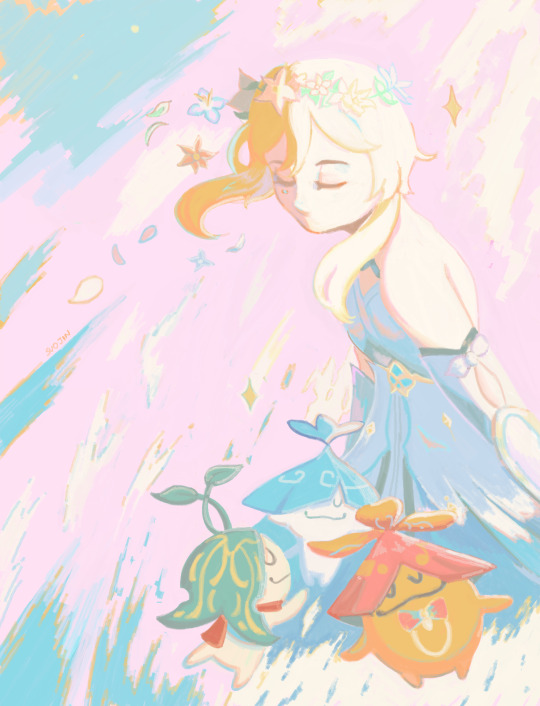
golden nara
.
another mspaint piece and thank god im done with this quest !!
59 notes
·
View notes
Text
aranyaka gayming
i fell in love with little silly forest babies ( ̄ω ̄)
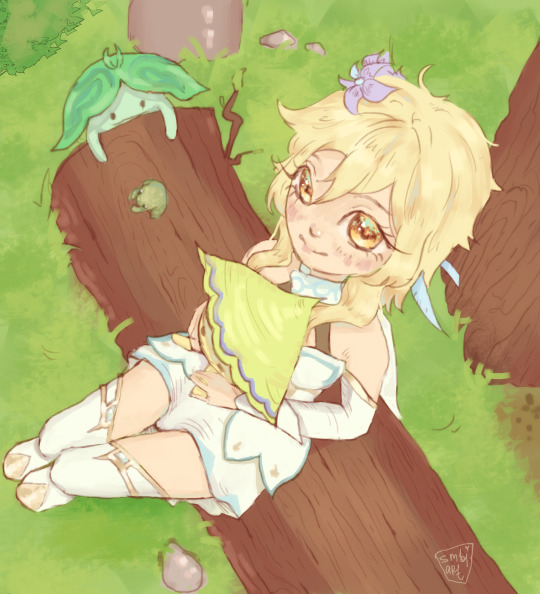
i simplifyed her dress a little bit. genshin characters have so much details on their clothes (*_ _)人
7 notes
·
View notes
Text

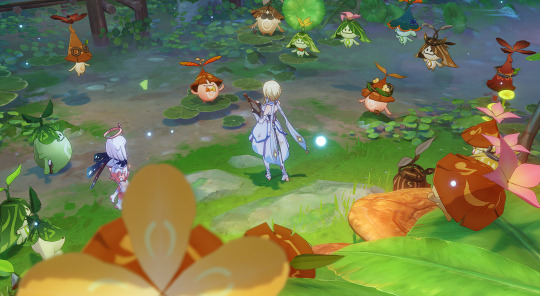
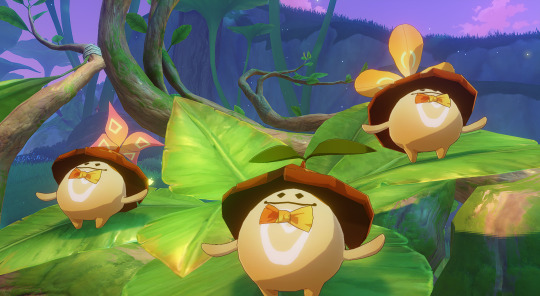
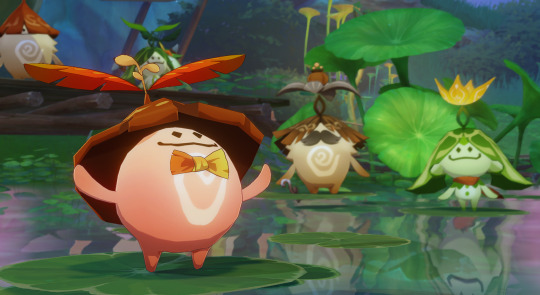



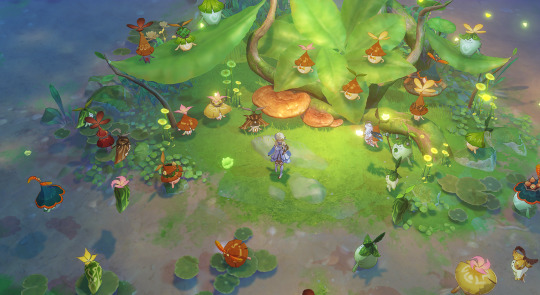
Rhythm of the Great Dream
11 notes
·
View notes
Text
I DID IT
I did it
Oh man I think that actually physically hurt me while I was doing it
And to those that want to discuss this…SPOILERS AHEAD
To the other people who have finished this quest and read the dialogue, do you guys think Nara Varuna was the abyss twin? If they were, that would be pretty messed up
I chose Lumine as the main character and the aranara were constantly talking about how Nara Varuna was “just like us”, “a golden Nara”, and would always talk about their sister
I thinks it’s interesting that Nara Varuna taught the aranara about family, and now the closer groups of aranara - like the Brothers - would all call their “family members” their YOUNGER SISTERS
And Lumine canonically is the YOUNGER sibling
I dunno it’s just something I’ve thought about
Today I start the aranara world quest in Sumeru
I will finish without skipping dialogue
Probably
…hopefully
I’ve heard that this quest is really long but I hope it’s not like SUPER long
It’s probably fine
1 note
·
View note
Text
Fighting off writer's block again and one thing I'm definitely noticing with reading over my earlier stuff to reference it in Seeds of Courage is that there’s one experience from early-game Genshin that's really stuck with me.
That being wandering into Sumeru looking for character ascension materials, stumbling into the Aranyaka questline, and then proceeding to disappear into the rainforest with Rana and the Aranara for an extended period of time. And I think that really shows in my Sumeru-centric fics.
And I hadn't even made it to Inazuma yet. I just got Very Lost in a magical forest rather than do the Archon Quest and it was very fun.
#genshin#sumeru#aranara#the aranyaka questline gets a lot of flak but I found it really relaxing#genshin's Breath of the Wild vibes really showed through here#this takes me back to when my main team was candace/dendro lumine/layla/kuki shinobu#not the most meta team but that hyperbloom squad carried me through two and a half Archon Quests
2 notes
·
View notes
Text
List of questlines I haven't finished/started on in Genshin Impact.
Dragonspine (I can never seem to finish that one in the ice cave)
Chasm Delvers (I'm afraid of that giant Ruin Grader)
Tsurumi Island (damn riftwolves keep killing me)
Enkanomiya (haven't started)
Aranyaka Quest (It's so damn long!!)
#genshin impact#genshin quests#dragonspine#tsurumi island#genshin chasm#enkanomiya#aranyaka quest#seriously by the time I'm done with any of these and get to fontaine#the game will be in the next region
4 notes
·
View notes
Text
The final chapter of Nara Agni and the Memory of Death is up! 🎉
I haven't talked about this fic as much as I ought to have since September 2022 (v3.0) when it began. Suffice to say, it's a Hu Tao fic: at times whimsical, at times wistful, at times deep with grief.
Join Hu Tao, Aragaru, Aranakin, and Aranaga, on their quest to save Mawtiyima, and, perhaps, die trying.
17 notes
·
View notes
Text

The best Genshin meme I ever heard🤣
#genshin impact#aranyaka quest#saving rana become forgotten quest lol#but wow 11 hours#kind of reminder how hussle that quest is
6 notes
·
View notes
Text
SPOILER
OMG THEY KNOW!!! 😲 THEY KNOW I WAS ABOUT TO DO THE AQ IN THE DESERT BUT WENT AND DO THE ARANYAKA QUEST INSTEAD 😲😲😲

0 notes
Text
theres this tiktok about alhaitham smiling & his ahoge spun around like the thingies atop an aranara's head which is so. cute. how do i explain my thoughts on this. alhaitham, a fully grown and Very Logical and Stoic Adult Man, being linked in any way to the aranara, fairy thingies that appear to children and follow lines of logic not quite comprehensible to us
#i did aranyaka in one sitting 💥💥💥💥#audio was the 'have you ever seen a grown man smile?' moistcritikal clip
1 note
·
View note
Text
spent most of the afternoon running around sumeru looking for the 76 aranara (thank god i found a guide) and i still have 26 left i wanna cry
#im actually one of the 5 people who like that questline but yeah this part is a bit too much#genshin impact#genshin aranyaka#genshin aranara#my post
0 notes
Text
love how you get 5x as many reputation points for beating up a ruin hunter who’s being a nuisance versus saving the world by helping the aranara defeat Marana
#seriously. The Aranyaka quest gives 20 points. Killing a weekly bounty gives 100 points. I'm....#all that effort. days of work. for 20 points. lmao.#shutup pigeon lord
0 notes
Text
give it up for trofin snezhevich am I right
#if you forgot who he is he gets revealed at the end of aranyaka#orphan (?) adopted by the snezhnayan house of the hearth and then got a mission to capture aranara#anyways imo he has the coolest non lore relevant npc lines taking into account the fact that he isn't even a permanent npc lol#'i'm the evil amidst good the poison amidst the herbs the wolf in sheep's clothing the mercury in a golden chalice... my name is#is snezhevich. do your worst!' hellooooooo best pre fight lines ever#yeah yeah those are shared by all house of the hearth members but he's the only one we've met who says them so theyre still his#also intrigued by the house of the hearth in general but i don't expect more of that lore until at least 2 yrs later rip#ramblings!#liveblog insanity
0 notes